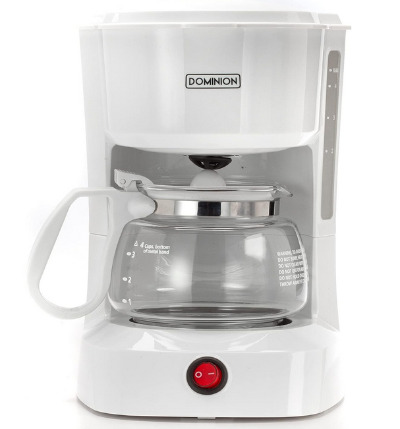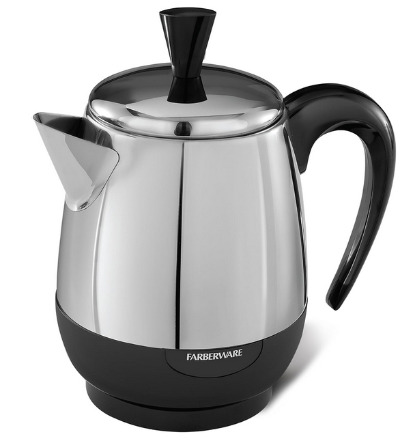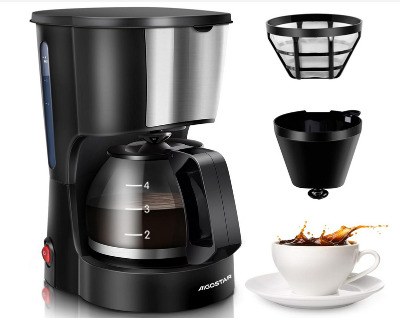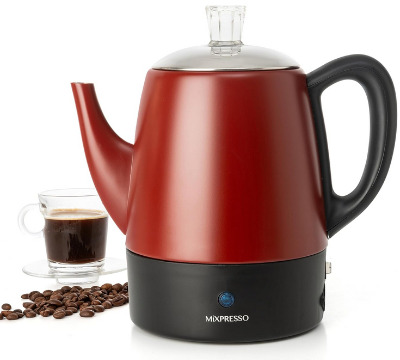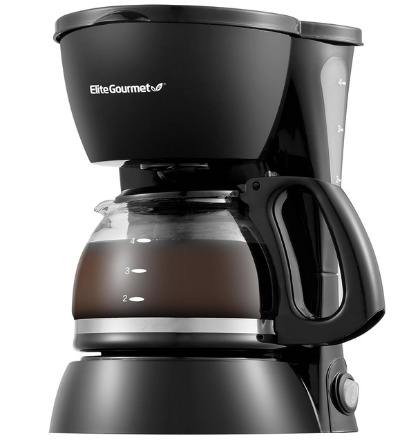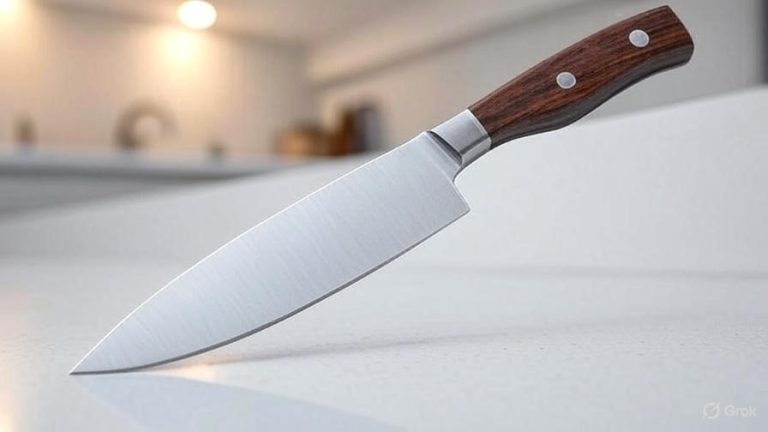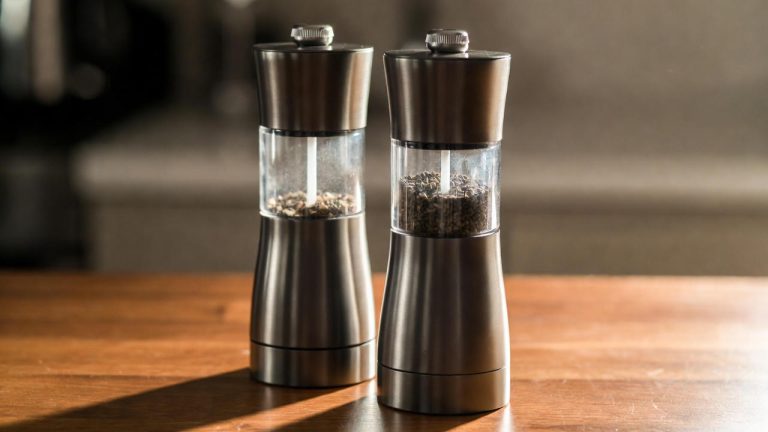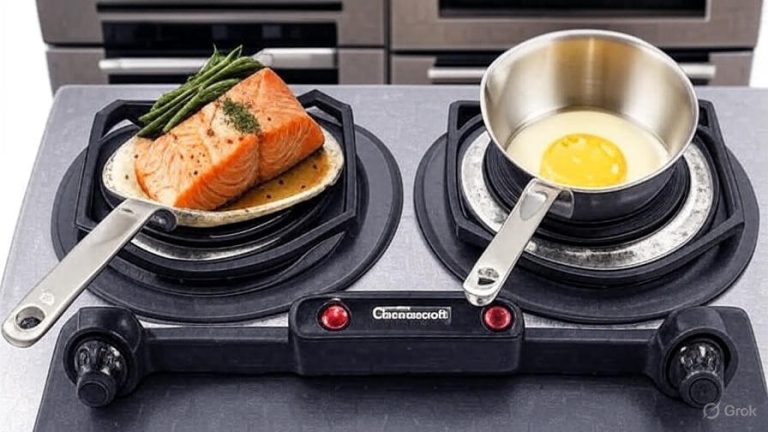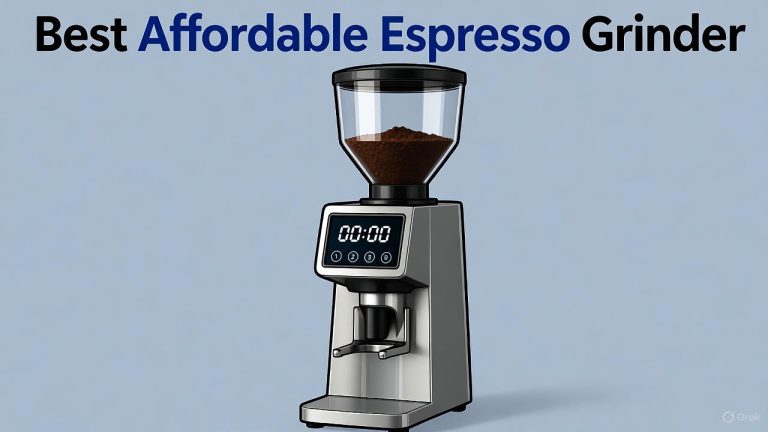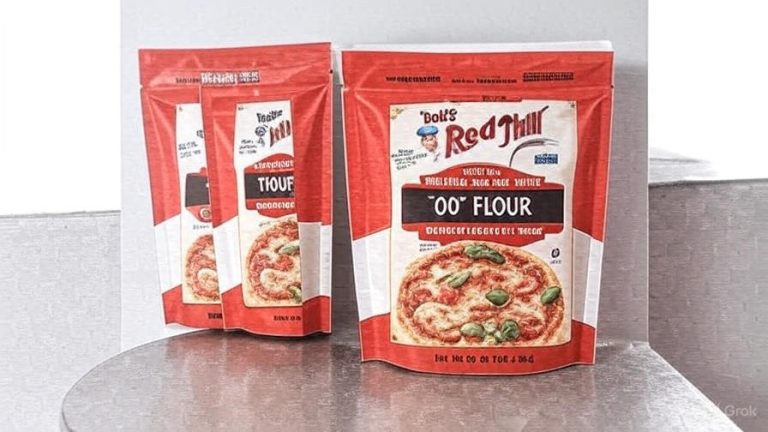5 Best 4 Cup Coffee Makers In 2025
Small households, solo coffee drinkers, and office workers often find themselves torn between instant coffee and brewing an entire 12-cup pot. The solution lies in compact 4-cup coffee makers that deliver freshly brewed coffee without waste or compromise. These space-saving appliances have revolutionized morning routines for millions of coffee enthusiasts who value quality over quantity.
The 4-cup coffee maker market has exploded with innovative designs that pack professional-grade features into surprisingly compact units. From traditional drip brewers to electric percolators, today’s small coffee makers offer impressive versatility while maintaining countertop efficiency. This comprehensive guide explores the five best 4-cup coffee makers available today, examining their unique features, brewing capabilities, and value propositions.
Why 4-Cup Coffee Makers Are Perfect for Modern Living
Compact living spaces demand efficient appliances that maximize functionality while minimizing footprint. A 4-cup coffee maker serves this purpose perfectly, delivering exactly the right amount of coffee for one to two people without the excess that larger machines produce. These brewers typically consume 20-25 ounces of water, producing four standard 6-ounce cups or two generous 12-ounce servings.
Energy efficiency represents another compelling advantage of smaller coffee makers. They heat less water, use less electricity, and reach optimal brewing temperature faster than their larger counterparts. This translates to quicker morning routines and lower utility bills over time. The reduced brewing time also means fresher coffee, as the entire batch gets consumed while still hot and flavorful.
Space-constrained environments benefit tremendously from these compact brewers. Dorm rooms, small apartments, RVs, and office breakrooms often lack the counter space for traditional coffee makers. A 4-cup model fits comfortably in tight spaces while still delivering café-quality results. Many models also feature cord storage and stackable designs that further maximize space efficiency.
Understanding Different Brewing Technologies
The 4-cup coffee maker category encompasses two primary brewing methods: drip brewing and percolation. Each technology offers distinct advantages and produces noticeably different flavor profiles that appeal to different taste preferences.
Drip coffee makers prioritize ease and efficiency in coffee routines, with many automatic models featuring programmable settings that can have filter coffee ready upon waking. They often feature automatic start and stop functions, allowing users to simply add water and coffee grounds, then wait for brewing to complete. The drip method involves heating water to optimal temperature (195-205°F) and allowing it to flow through coffee grounds once, extracting flavors gradually and evenly.
Percolators operate on a completely different principle, cycling hot water repeatedly through coffee grounds until desired strength is achieved. Most drip makers don’t get half the flavor from coffee that a percolator can achieve, making percolators perfect for strong coffee that doesn’t have to be bitter. This brewing method creates a more robust, full-bodied cup that many coffee enthusiasts prefer for its intensity and traditional character.
The choice between these technologies often comes down to personal preference and lifestyle considerations. Drip brewers excel in convenience and consistency, while percolators offer greater control over strength and produce a more distinctive coffee flavor. Both technologies have been refined significantly in recent designs, incorporating modern features like automatic shut-off, keep-warm functions, and improved temperature control.
Our Top 5 Best 4-Cup Coffee Makers Reviewed
1. Dominion 4-Cup Coffeemaker – Best Overall Value
The Dominion 4-Cup Coffeemaker represents exceptional value in the compact brewing category, combining essential features with reliable performance at an accessible price point. This drip-style brewer delivers consistent results through its well-engineered brewing system that maintains optimal water temperature throughout the extraction process.
Key Features and Performance
The Dominion’s quiet operation sets it apart from many competitors that produce disruptive noise during brewing cycles. The unit incorporates sound-dampening technology that reduces operating noise to barely perceptible levels, making it ideal for early morning brewing without disturbing household members. The LED indicator light provides clear visual confirmation of brewing status, eliminating guesswork about when coffee is ready.
Convenience features elevate this model above basic alternatives. The auto-pause function allows users to pour a quick cup mid-brew without creating spills or messes. This feature proves invaluable during busy mornings when every minute counts. The anti-drip design prevents coffee from dripping onto the hot plate after the carafe is removed, maintaining cleanliness and safety.
Cord storage built into the base keeps counters tidy and prevents tangled cables. This seemingly minor feature significantly improves kitchen organization, especially in space-limited environments where every inch of counter space matters. The compact footprint measures just 8 inches wide, fitting comfortably even on crowded countertops.
Design and Build Quality
Construction quality impresses with durable plastics that resist cracking and fading over time. The heating element delivers consistent temperature control, ensuring proper extraction without over-brewing or under-brewing. The carafe features a comfortable handle that stays cool during brewing, preventing accidental burns.
The brewing basket accommodates standard #2 cone filters or reusable metal filters for eco-conscious users. Filter placement is intuitive, reducing morning fumbling when cognitive function isn’t at peak levels. The water reservoir includes measurement markings that align with cup quantities, eliminating guesswork about water-to-coffee ratios.
Pros and Cons
Advantages include ultra-quiet operation, reliable brewing performance, convenient auto-pause feature, and compact design that fits tight spaces. The LED indicator provides helpful status information, while cord storage maintains counter organization. Value pricing makes this model accessible to budget-conscious consumers.
Disadvantages center on basic aesthetics that may not complement premium kitchen designs. The carafe lacks thermal insulation, requiring the hot plate for temperature maintenance. Some users report that the hot plate can over-heat coffee if left on extended periods, potentially affecting flavor quality.
2. Farberware Electric Coffee Percolator FCP240 – Best Traditional Brewing
The Farberware FCP240 brings traditional percolator brewing into the modern era with stainless steel construction and automatic convenience features. This electric percolator produces notably strong, full-bodied coffee that appeals to users who prefer robust flavor profiles over mild brews.
Percolator Brewing Excellence
The stainless steel brewing basket ensures optimal heat distribution and flavor extraction while resisting corrosion and staining. Unlike aluminum alternatives, stainless steel won’t impart metallic flavors to coffee, preserving the beans’ natural characteristics. The percolation process cycles water repeatedly through grounds, building strength gradually until desired intensity is reached.
Temperature control in this model excels at maintaining consistent brewing conditions throughout the cycle. The heating element provides steady power that brings water to boiling quickly, then moderates temperature to sustain optimal percolation without over-extraction. This balance requires sophisticated engineering that Farberware has perfected through decades of percolator manufacturing.
The automatic keep-warm function activates once brewing completes, maintaining serving temperature without continuing the percolation process. This prevents over-extraction while ensuring coffee stays hot for extended periods. The feature proves particularly valuable in office environments where coffee consumption spans several hours.
Design and Construction
Stainless steel construction extends beyond the brewing basket to include the entire percolator body. This material choice provides superior durability compared to plastic alternatives while offering better heat retention. The polished finish resists fingerprints and maintains an attractive appearance with minimal maintenance.
The no-drip spout design prevents counter messes and coffee waste. Spout engineering incorporates precise angles and edge treatments that create clean pours without dribbling or splashing. This attention to detail reflects Farberware’s commitment to user experience and kitchen cleanliness.
Handle ergonomics receive careful consideration with heat-resistant materials and comfortable grip geometry. The handle remains cool even during brewing cycles, allowing safe manipulation without protective gear. Balance is well-engineered, preventing tip-over incidents when pouring.
Performance Analysis
Brewing speed impresses with complete cycles finishing in under 10 minutes from cold start. The rapid heating capability makes this percolator suitable for rushed morning schedules or office environments where time efficiency matters. Water capacity accommodates exactly 4 cups without waste or shortfall.
Flavor extraction produces notably strong coffee that percolator enthusiasts appreciate. The repeated cycling action extracts more oils and compounds than single-pass drip methods, creating a full-bodied cup with distinctive character. Users who prefer mild coffee may find the results too intense even with reduced brewing times.
Temperature maintenance through the keep-warm function sustains drinking temperature for up to 2 hours without significant quality degradation. The automatic feature eliminates manual monitoring while preventing over-extraction that could produce bitter flavors.
Strengths and Limitations
Strengths include superior build quality through stainless steel construction, excellent flavor extraction that produces robust coffee, reliable automatic functions including keep-warm, and efficient brewing speed that fits busy schedules. The no-drip spout prevents messes while the durable construction ensures long-term reliability.
Limitations involve the learning curve associated with percolator brewing, as optimal timing requires experimentation to achieve preferred strength. The brewing process produces more noise than drip alternatives, potentially disturbing quiet environments. Strong flavor output may not appeal to users who prefer mild coffee profiles.
3. Aigostar Buck Coffee Maker – Best Design and Features
The Aigostar Buck combines sleek aesthetics with practical functionality, creating a 4-cup drip coffee maker that enhances kitchen décor while delivering reliable brewing performance. The black finish with stainless steel accents provides contemporary styling that complements modern appliances and design schemes.
Advanced Feature Set
The glass carafe offers superior heat retention compared to plastic alternatives while allowing visual monitoring of brewing progress. Glass construction won’t absorb flavors or odors over time, ensuring every batch tastes fresh without residual contamination from previous brews. The carafe capacity precisely measures 4 cups with clear graduation marks for accurate filling.
Stainless steel decorative elements provide durability and visual appeal while resisting corrosion and tarnishing. These accents create premium appearance that justifies the slightly higher price point compared to basic alternatives. The metal components also contribute to better heat distribution during the brewing process.
The included coffee filter eliminates the need for disposable paper filters, reducing operating costs and environmental impact. The permanent filter features fine mesh construction that blocks grounds while allowing oils and flavor compounds to pass through. This design produces cleaner coffee than paper filters while maintaining full flavor extraction.
Versatility and Convenience
Compact dimensions make this model suitable for various environments including homes, offices, and travel accommodations. The small footprint doesn’t compromise functionality, as all essential brewing components fit efficiently within the space-saving design. Cord length provides adequate reach for most counter configurations.
The drip-stop feature prevents messes when removing the carafe during brewing. This anti-drip mechanism activates automatically when the carafe is lifted, stopping coffee flow until the carafe returns to position. The feature proves invaluable for impatient coffee drinkers who can’t wait for complete brewing cycles.
Water reservoir design includes measurement markings that correspond to cup quantities, eliminating guesswork about proper water levels. The reservoir removes easily for filling and cleaning, with ergonomic handling that prevents drops and spills during refilling operations.
Build Quality Assessment
Construction quality meets expectations for the price range with durable plastics that resist impact and temperature stress. The heating element provides consistent performance with even temperature distribution that ensures proper extraction without hot spots or cold zones. Component fit and finish reflect attention to manufacturing quality.
The brewing basket accommodates both the included permanent filter and standard #2 paper filters for user preference flexibility. Basket removal for cleaning requires no tools and features intuitive handling that makes maintenance straightforward. The basket design prevents grounds from bypassing the filter during brewing.
Electronic components include a simple on/off switch with LED indicator that shows brewing status. The indicator remains illuminated during brewing cycles and automatically turns off when the cycle completes. This basic control system prioritizes reliability over advanced features.
Performance Evaluation
Brewing performance delivers consistent results with even extraction and appropriate temperature control. The heating element reaches optimal brewing temperature quickly and maintains steady heat throughout the cycle. Water distribution over coffee grounds appears uniform, suggesting well-designed shower head engineering.
Coffee quality matches expectations for drip brewing with clean flavor profiles that highlight bean characteristics without over-extraction artifacts. The permanent filter allows more oils to pass through compared to paper alternatives, creating slightly fuller body that some users prefer. Filter maintenance requires regular cleaning to prevent oil buildup.
Temperature maintenance relies on the glass carafe’s thermal properties rather than an active heating plate. This approach prevents over-heating but means coffee will cool gradually after brewing completes. The glass retains heat longer than plastic but shorter than thermal carafes or heated plates.
Advantages and Drawbacks
Advantages encompass attractive design with stainless steel accents, included permanent filter that reduces operating costs, reliable drip brewing performance, and compact size suitable for various environments. The glass carafe provides durability and flavor neutrality while the anti-drip feature prevents counter messes.
Drawbacks include the lack of keep-warm functionality, which means coffee will cool naturally after brewing. The permanent filter requires regular cleaning and may allow fine particles to pass through compared to high-quality paper filters. Price positioning places this model slightly above basic alternatives without significant feature advantages.
4. Mixpresso Red Small Percolator Coffee Pot – Best for Strong Coffee
The Mixpresso Red Percolator delivers traditional percolator brewing in an eye-catching red finish that adds personality to kitchen counters. This electric percolator specializes in producing strong, full-bodied coffee that appeals to users who prefer robust flavor profiles over mild alternatives.
Distinctive Design Elements
The vibrant red exterior finish creates visual impact that transforms this functional appliance into a design statement. The color choice reflects growing trends toward personality in kitchen appliances, moving beyond basic black and white options that dominated previous generations. The finish quality resists fading and maintains color integrity through regular use.
Stainless steel construction forms the core brewing components, ensuring durability and flavor neutrality. The steel brewing basket won’t impart metallic tastes while providing excellent heat distribution for optimal extraction. This material combination of colorful exterior and stainless interior offers the best of both aesthetic appeal and functional performance.
Compact proportions suit space-limited environments while maintaining 4-cup capacity. The percolator profile is inherently taller than drip alternatives due to the internal tube structure, but the base footprint remains minimal. This vertical design actually conserves counter space compared to sprawling drip makers.
Percolator Technology Benefits
The percolation process creates distinctly different coffee compared to drip methods, with stronger flavor and fuller body that appeals to traditional coffee preferences. Water cycles repeatedly through grounds, extracting progressively more flavor compounds until desired strength develops. This method allows precise control over coffee strength through timing adjustments.
Heat distribution through the stainless steel components ensures even extraction without cold spots that can create inconsistent flavor. The heating element provides steady power that maintains optimal percolation temperature without overheating water to boiling throughout the entire cycle. This temperature control requires sophisticated engineering in compact appliances.
The brewing basket design accommodates coarser grinds that work optimally with percolator brewing. Fine grinds can over-extract during the multiple cycling process, while coarser particles allow proper water flow and balanced extraction. This grind requirement actually simplifies coffee preparation compared to drip methods that require precise grind sizing.
Functional Features
The keep-warm function maintains serving temperature after brewing completes, preventing heat loss while avoiding continued percolation that could over-extract coffee. This automatic feature eliminates manual monitoring while ensuring coffee stays hot for extended consumption periods. The function typically maintains temperature for 1-2 hours before automatic shut-off.
The 4-cup capacity provides exactly the right amount for small households or individual consumption over extended periods. Percolator coffee tends to stay hot longer than drip alternatives due to the brewing method and construction materials. This thermal retention makes smaller batches practical for solo coffee drinkers.
Operation simplicity appeals to users who prefer straightforward brewing without complex controls or programming. The basic on/off operation eliminates confusion while ensuring reliable performance. Visual indicators show brewing progress through the traditional percolator dome, allowing monitoring without lifting lids or guessing completion times.
Quality and Construction
Build quality reflects solid engineering with durable components that withstand daily use. The heating element provides consistent performance with appropriate power levels for efficient brewing. Electrical components meet safety standards with proper insulation and circuit protection against overheating or electrical faults.
The brewing basket construction uses fine mesh or perforated metal that contains grounds while allowing proper water circulation. Basket fit prevents bypass that could allow grounds into finished coffee. Cleaning requires attention to remove oil buildup, but the stainless steel materials resist staining and corrosion.
Handle design incorporates heat-resistant materials that stay cool during brewing and pouring operations. Handle attachment points are reinforced to prevent loosening or failure under the stress of regular handling. Balance is engineered to prevent tip-over incidents when pouring full carafes.
Performance Analysis
Brewing speed competes well with drip alternatives, typically completing 4-cup cycles in 8-10 minutes from cold start. The percolation process is inherently self-timing, as visible bubble activity indicates brewing progress. Users learn to judge optimal strength through experience with their preferred coffee types and personal taste preferences.
Coffee strength exceeds most drip alternatives due to the repeated extraction process. This intensity appeals to users who find drip coffee too weak but may overwhelm those accustomed to milder profiles. Strength can be moderated through shorter brewing times, but this requires experimentation to achieve desired results.
Temperature performance maintains serving heat through the keep-warm function while avoiding over-extraction. The stainless steel construction retains heat effectively, often keeping coffee warm for extended periods even after the heating element cycles off. This thermal efficiency contributes to energy savings over time.
Benefits and Considerations
Benefits include distinctive visual appeal through the red finish, superior coffee strength through percolator brewing, reliable keep-warm functionality, and durable stainless steel construction. The traditional brewing method produces full-bodied coffee with robust flavor that appeals to strong coffee preferences.
Considerations involve the learning curve associated with percolator timing, higher noise levels during brewing compared to drip alternatives, and strong flavor output that may not suit all taste preferences. The distinctive appearance may not complement all kitchen design schemes, though many users appreciate the personality it adds.
5. Elite Gourmet EHC4128 – Best Budget Option
The Elite Gourmet EHC4128 delivers essential 4-cup brewing capability at an exceptional price point, making quality coffee accessible to budget-conscious consumers without sacrificing fundamental performance. This drip-style brewer focuses on reliable functionality rather than premium features, creating value through simplicity and dependability.
Essential Features Done Right
The Pause N Serve function represents the most important convenience feature for small coffee makers, allowing users to grab a quick cup before brewing completes. Elite Gourmet implements this feature effectively with reliable activation when the carafe lifts and proper sealing when replaced. The mechanism prevents dripping and maintains brewing temperature during brief interruptions.
The glass carafe provides durability and flavor neutrality at a fraction of the cost of thermal alternatives. Glass won’t absorb odors or flavors over time, ensuring consistent taste quality through extended use. The carafe includes measurement markings that align with the 4-cup capacity, eliminating guesswork about proper filling levels.
The reusable filter eliminates ongoing paper filter costs while providing adequate filtration for most coffee types. The permanent filter construction uses fine mesh that blocks grounds while allowing oils and flavor compounds to pass through. This design produces slightly fuller-bodied coffee compared to paper filter alternatives while reducing operating expenses.
Simple Operation Philosophy
The basic on/off switch operation appeals to users who prefer straightforward functionality over complex controls. This simplicity reduces potential failure points while making the machine accessible to all family members regardless of technical expertise. The switch includes position indicators that show current operating status.
The keep-warm plate maintains serving temperature after brewing completes, preventing heat loss while avoiding the over-extraction that can occur with continued brewing. The plate temperature is calibrated to maintain coffee heat without creating the burnt flavors that overly hot plates can produce. This feature typically operates for 1-2 hours before automatic shut-off.
Water level indicators built into the reservoir show proper filling amounts corresponding to cup quantities. These markings eliminate measurement guesswork while preventing overfilling that could cause overflow during brewing. The reservoir design allows easy filling directly from faucets or water pitchers.
Construction and Reliability
Build quality prioritizes reliability over premium aesthetics, using durable plastics and proven heating elements that provide consistent performance. The construction materials resist impact and temperature stress while maintaining dimensional stability through repeated heating and cooling cycles. Component selection emphasizes proven reliability over cutting-edge innovation.
The heating element delivers appropriate power levels for efficient brewing without excessive energy consumption. Temperature control maintains optimal extraction conditions throughout the brewing cycle, ensuring consistent results regardless of ambient conditions. The element design incorporates safety features that prevent overheating or electrical hazards.
The brewing basket accommodates both the included permanent filter and standard #2 paper filters for user preference flexibility. Basket design prevents grounds bypass while allowing easy removal for cleaning. The fit tolerance ensures proper sealing that prevents water from flowing around rather than through the coffee bed.
Performance Assessment
Brewing performance meets expectations for the price category with consistent extraction and appropriate temperature control. The heating element reaches brewing temperature efficiently and maintains steady heat throughout the cycle. Water distribution appears uniform based on even extraction visible in finished coffee.
Coffee quality reflects typical drip brewing characteristics with clean flavor profiles that highlight bean qualities without significant over-extraction or under-extraction artifacts. The permanent filter allows slightly more oils through compared to paper alternatives, creating marginally fuller body that some users prefer. Flavor neutrality prevents interference with coffee taste.
Temperature maintenance through the keep-warm plate sustains drinking temperature for extended periods without the gradual cooling that occurs with non-heated carafes. The plate temperature avoids over-heating while providing sufficient warmth for comfortable consumption. Automatic shut-off prevents energy waste and safety hazards.
Value Analysis
Value positioning makes this model attractive to budget-conscious consumers who need reliable brewing without premium features. The price point often runs 30-50% below comparable alternatives while delivering essential functionality. Cost savings come through simplified construction rather than compromised performance.
Feature completeness includes all essential brewing functions without unnecessary complexity that could increase costs or reduce reliability. The Pause N Serve, keep-warm, and reusable filter features provide the convenience most users require for daily coffee preparation. The glass carafe offers durability advantages over plastic alternatives found in some budget models.
Long-term ownership costs remain low due to the reusable filter and energy-efficient heating element. The simple construction reduces maintenance requirements while using readily available replacement parts if repairs become necessary. This design philosophy prioritizes longevity over flashy features.
Strengths and Limitations
Strengths encompass exceptional value pricing, reliable brewing performance, essential convenience features including Pause N Serve and keep-warm functions, and durable glass carafe construction. The reusable filter reduces operating costs while the simple operation appeals to users who prefer straightforward functionality.
Limitations include basic aesthetics that may not complement premium kitchen designs, lack of advanced features like programmable timing or specialty brewing modes, and construction materials that prioritize function over premium appearance. The keep-warm plate may over-heat coffee if left on for extended periods beyond the intended timeframe.
Key Features to Consider When Buying
Successful 4-cup coffee maker selection requires evaluating specific features that directly impact daily usability and long-term satisfaction. Each feature category plays distinct roles in the overall brewing experience, from convenience and performance to maintenance and durability considerations.
Brewing Technology Choice
The fundamental decision between drip and percolator brewing affects every aspect of coffee quality and user experience. Drip coffee makers prioritize ease and efficiency, with many automatic models featuring programmable settings that can have filter coffee ready upon waking. This technology appeals to users who value convenience and consistent results with minimal involvement.
Percolator brewing offers greater control over coffee strength while producing distinctly different flavor profiles. The repeated water cycling extracts more oils and compounds, creating fuller-bodied coffee that appeals to traditional preferences. However, percolators require more attention during brewing to prevent over-extraction.
Consider personal taste preferences and lifestyle requirements when making this choice. Busy schedules often favor drip convenience, while users who enjoy the brewing ritual may prefer percolator involvement. Both technologies have been refined significantly in modern designs, incorporating safety features and automatic functions.
Essential Convenience Features
Auto-pause or pause-and-serve functionality ranks among the most valuable convenience features for small coffee makers. This capability allows pouring a quick cup mid-brew without creating spills or waiting for complete cycles. The feature proves particularly valuable during rushed morning schedules when every minute counts.
Keep-warm functions maintain serving temperature after brewing completes, preventing the gradual cooling that makes coffee unpalatable. Heated plates or thermal retention systems sustain drinking temperature for 1-2 hours typically, though extended heating can affect flavor quality. Consider how long coffee typically sits before consumption when evaluating this feature.
Programmable timers enable automatic brewing at preset times, ensuring fresh coffee waits upon waking. This feature transforms morning routines by eliminating manual startup while guaranteeing optimal brewing timing. However, programmable functions add complexity and potential failure points that some users prefer to avoid.
Build Quality and Materials
Carafe construction significantly affects durability, heat retention, and flavor neutrality. Glass carafes resist flavor absorption and provide visual brewing monitoring but can break if dropped. Stainless steel offers superior durability and heat retention while maintaining professional appearance. Plastic alternatives cost less but may absorb flavors over time.
Heating element quality determines temperature consistency and long-term reliability. Higher-quality elements maintain steady brewing temperature throughout cycles while resisting mineral buildup and corrosion. Element power levels should match brewing capacity to ensure efficient operation without excessive energy consumption.
Internal component materials affect both performance and longevity. Stainless steel brewing baskets resist corrosion while providing even heat distribution. Plastic components should use temperature-resistant grades that won’t warp or degrade under brewing conditions. Quality construction ensures years of reliable service.
Size and Space Considerations
Counter space limitations often drive 4-cup coffee maker selection, making compact footprints essential for space-limited environments. Measure available counter space carefully, considering both the machine footprint and clearance needed for operation. Some models feature cord storage that further reduces space requirements.
Vertical clearance becomes important for models with hinged lids or tall profiles. Ensure adequate space exists above the machine for normal operation, including filter access and carafe removal. Cabinet-mounted coffee makers may have specific clearance requirements for proper ventilation and operation.
Storage considerations apply to occasional-use scenarios or seasonal residents who may need to store coffee makers between uses. Compact models with detachable components often store more efficiently than larger alternatives. Consider disassembly requirements and storage space availability.
Maintenance and Care Tips
Proper maintenance extends coffee maker lifespan while ensuring consistent brewing performance and flavor quality. Regular cleaning prevents mineral buildup, removes coffee oil residues, and maintains optimal operation of all mechanical and heating components.
Daily Cleaning Routine
Daily maintenance should include thorough rinsing of all removable components that contact coffee or water. The carafe, brewing basket, and lid require washing with warm soapy water to remove coffee oils that can turn rancid and affect flavor. These oils build up gradually and become increasingly difficult to remove without regular attention.
Water reservoir cleaning prevents bacterial growth and mineral accumulation that can affect both taste and brewing performance. Empty and rinse the reservoir daily, wiping surfaces with clean cloth to remove water spots and residues. Allow components to air dry completely before reassembly to prevent moisture retention.
Filter maintenance depends on the type used. Paper filters should be discarded after each use, while permanent filters require thorough rinsing to remove coffee oils and fine particles. Permanent filters may need periodic deep cleaning with specialized cleaners designed for coffee equipment.
Weekly Deep Cleaning
Weekly deep cleaning involves disassembling all removable components for thorough washing and inspection. Use warm soapy water and soft brushes to reach crevices where coffee residues accumulate. Pay particular attention to thread areas, spout interiors, and basket perforations that can harbor stubborn deposits.
Carafe cleaning may require specialized approaches depending on material construction. Glass carafes benefit from occasional cleaning with baking soda solutions that remove stubborn stains and neutralize odors. Stainless steel components may develop water spots that require specialized stainless cleaners for optimal appearance.
Heating plate maintenance involves wiping surfaces with damp cloths to remove coffee stains and mineral deposits. Avoid abrasive cleaners that could scratch surfaces or damage heating elements. Some models feature removable plates that allow more thorough cleaning access.
Descaling and Mineral Removal
Mineral buildup from hard water represents the most significant long-term maintenance challenge for coffee makers. Calcium and magnesium deposits accumulate in heating elements and water passages, reducing efficiency and potentially causing premature failure. Regular descaling prevents these problems while maintaining optimal brewing temperature.
Commercial descaling solutions designed specifically for coffee makers provide the most effective mineral removal. These products dissolve mineral deposits safely without damaging internal components or leaving harmful residues. Follow manufacturer instructions carefully regarding solution strength and contact times.
Natural descaling alternatives include white vinegar solutions that provide effective mineral removal at lower cost. Mix equal parts vinegar and water, run a complete brewing cycle, then flush thoroughly with clean water to remove vinegar residues. This process may require multiple clean water cycles to eliminate vinegar taste completely.
Troubleshooting Common Issues
Slow brewing often indicates mineral buildup in water passages or heating elements. Descaling typically resolves these issues by removing deposits that restrict water flow. If problems persist after descaling, professional service may be required to address more serious blockages.
Weak coffee can result from improper coffee-to-water ratios, inadequate brewing temperature, or clogged filters. Check grind size, coffee quantity, and filter condition before assuming equipment malfunction. Water temperature problems may indicate heating element issues requiring professional repair.
Unusual noises during brewing may signal air bubbles in water lines, loose components, or heating element problems. Ensure all components are properly seated and tightened. Persistent noise issues may indicate internal damage requiring professional evaluation.
Buying Guide: Making the Right Choice
Successful 4-cup coffee maker selection requires balancing multiple factors including brewing preferences, space constraints, budget limitations, and feature requirements. This systematic approach ensures the chosen model will meet daily needs while providing satisfactory long-term performance.
Assessing Your Coffee Needs
Coffee consumption patterns directly influence the optimal brewing capacity and features needed. Users who drink coffee throughout the day may prioritize keep-warm functions and thermal retention, while those who consume coffee quickly after brewing can focus on brewing speed and flavor quality. Consider typical consumption timing and quantity when evaluating options.
Taste preferences significantly impact brewing technology selection. Users who prefer strong, full-bodied coffee may favor percolator brewing, while those who appreciate subtle flavor nuances might choose drip alternatives. Consider current coffee preparation methods and satisfaction levels with existing flavor profiles.
Convenience requirements vary dramatically among users and households. Busy schedules may prioritize programmable features and rapid brewing, while leisurely coffee routines might value traditional brewing methods that require more involvement. Evaluate morning routines and time constraints when assessing convenience features.
Space and Installation Planning
Counter space measurement should include both the machine footprint and operational clearances needed for daily use. Consider lid opening space, carafe removal clearance, and access requirements for filter changes and cleaning. Some models require more operational space than their base dimensions suggest.
Electrical requirements typically involve standard household outlets, but consider outlet locations and cord length requirements. Built-in cord storage features help manage excess cord length while maintaining counter organization. Extension cord use should be avoided with high-power heating appliances.
Ventilation needs apply primarily to percolator models that produce more steam and aromas during brewing. Ensure adequate air circulation around the machine to prevent moisture buildup and odor concentration. Some installation locations may not provide sufficient ventilation for optimal operation.
Budget Considerations and Value
Initial purchase price represents only part of the total ownership cost for coffee makers. Consider ongoing expenses including filters, descaling solutions, and energy consumption when evaluating different models. Permanent filter options reduce long-term operating costs compared to paper filter requirements.
Feature value assessment should focus on functions that will actually be used regularly rather than impressive specifications that won’t impact daily experience. Complex features that go unused don’t justify higher prices, while essential convenience features provide excellent value regardless of cost.
Durability expectations should align with usage patterns and replacement budget planning. Higher-quality construction typically justifies premium pricing through extended service life and better performance consistency. However, basic models may provide adequate service for light-use applications at significantly lower cost.
Brand Reputation and Support
Manufacturer reputation for quality and customer service affects long-term ownership satisfaction. Research brand histories, customer reviews, and warranty policies when evaluating options. Established brands typically offer better parts availability and service support compared to unknown manufacturers.
Warranty coverage varies significantly among manufacturers and models, from basic limited warranties to comprehensive coverage including parts and labor. Extended warranty options may provide additional protection for premium models. Consider warranty terms alongside initial pricing when comparing value.
Customer service accessibility becomes important when problems arise or questions need answering. Brands with domestic customer service operations typically provide faster, more effective support compared to overseas-only support structures. Research customer service ratings and response times before making final decisions.
Final Recommendations and Conclusions
The 4-cup coffee maker market offers excellent options across all price ranges and brewing preferences, making it possible to find suitable models regardless of budget or feature requirements. Each of the five reviewed models excels in specific areas while providing reliable brewing performance that meets the needs of small households and individual coffee enthusiasts.
Best Overall Choice
The Dominion 4-Cup Coffeemaker emerges as the best overall value through its combination of reliable performance, convenient features, and accessible pricing. The quiet operation, auto-pause function, and compact design make it suitable for virtually any environment while delivering consistent brewing results. The balance of features and affordability makes this model appealing to the broadest range of users.
Specialty Recommendations
For users who prioritize traditional brewing methods and strong coffee, the Farberware Electric Coffee Percolator FCP240 provides exceptional percolator performance with modern convenience features. The stainless steel construction ensures durability while the automatic keep-warm function adds modern convenience to traditional brewing.
Budget-conscious consumers will find excellent value in the Elite Gourmet EHC4128, which provides essential brewing functionality at exceptionally affordable pricing. The glass carafe, pause-and-serve feature, and keep-warm function deliver the features most users need without premium pricing.
Making Your Decision
Consider your specific priorities when choosing among these excellent options. Convenience-focused users should prioritize drip brewing with automatic features, while coffee purists may prefer percolator brewing despite the additional involvement required. Space constraints, aesthetic preferences, and budget limitations will further narrow the selection.
The 4-cup coffee maker category continues evolving with improved features, better construction, and more competitive pricing. Any of these reviewed models will provide years of reliable service while delivering the fresh, hot coffee that makes mornings more enjoyable. The key lies in matching your specific needs with the right combination of features, brewing technology, and price point.
Frequently Asked Questions
What grind size works best for 4-cup coffee makers?
Medium grind coffee works optimally for most drip-style 4-cup coffee makers, providing balanced extraction without clogging filters or creating weak coffee. Percolator models perform better with coarser grinds that prevent over-extraction during the repeated cycling process. Avoid fine grinds that can create muddy coffee or clog permanent filters.
How much coffee should I use for 4 cups?
The standard ratio calls for 4-6 tablespoons of ground coffee for 4 cups of water, depending on desired strength. Start with 4 tablespoons for medium strength coffee and adjust according to taste preferences. Percolator brewing typically requires slightly less coffee due to the more intensive extraction process.
Can I use paper filters instead of permanent filters?
Most models with permanent filters also accommodate standard #2 cone paper filters for user preference. Paper filters may produce cleaner coffee with less sediment but require ongoing purchases. Permanent filters reduce operating costs while allowing more coffee oils through for fuller body.
How often should I descale my coffee maker?
Descaling frequency depends on water hardness and usage patterns. Hard water areas may require monthly descaling, while soft water locations can extend intervals to 3-4 months. Watch for slower brewing times or unusual noises that indicate mineral buildup requiring attention.
Is it safe to leave the keep-warm plate on all day?
Most keep-warm plates include automatic shut-off features that activate after 1-2 hours for safety and energy efficiency. Extended heating beyond this timeframe can over-cook coffee, creating bitter flavors and potentially damaging the heating element. Turn off manually if consuming coffee over extended periods.
What’s the difference between 4-cup and 5-cup coffee makers?
The capacity difference represents only 6-8 ounces of additional brewing volume, but 5-cup models often feature larger footprints and higher power consumption. Four-cup models provide better space efficiency for truly compact brewing needs while still serving 1-2 people adequately.
Advanced Tips for Perfect 4-Cup Coffee
Water Quality Optimization
Water quality significantly impacts coffee taste, as it comprises over 95% of the finished beverage. Hard water with high mineral content can create chalky, bitter flavors while interfering with proper extraction. Soft water may produce flat-tasting coffee that lacks body and complexity.
Filtered water provides the most consistent results by removing chlorine, sediment, and excess minerals that interfere with coffee flavors. Carbon filters effectively remove chlorine taste while leaving beneficial minerals that enhance extraction. Avoid distilled water, which can produce flat, lifeless coffee due to the absence of extraction-enhancing minerals.
Water temperature directly affects extraction quality, with optimal brewing occurring between 195-205°F. Most electric coffee makers heat water automatically, but altitude and ambient temperature can affect final brewing temperature. High-altitude locations may require models with more powerful heating elements to reach optimal temperature.
Coffee Bean Selection and Storage
Bean freshness plays a crucial role in coffee quality, with recently roasted beans producing significantly better results than stale alternatives. Purchase coffee in small quantities that can be consumed within 2-3 weeks of the roast date. Look for roast dates rather than expiration dates when evaluating coffee freshness.
Storage conditions affect bean quality dramatically. Keep coffee beans in airtight containers away from light, heat, and moisture. Room temperature storage in dark locations preserves quality better than refrigeration, which can introduce moisture and odor contamination. Avoid freezer storage unless beans are properly sealed and used quickly after thawing.
Grind timing impacts flavor significantly, with freshly ground coffee producing noticeably better results than pre-ground alternatives. Grind coffee just before brewing when possible, or purchase pre-ground coffee in small quantities for faster consumption. Burr grinders produce more consistent particle sizes than blade grinders for optimal extraction.
Brewing Technique Refinement
Coffee-to-water ratios can be adjusted to personal preferences while maintaining extraction quality. Start with standard ratios and adjust gradually to find the optimal strength for your taste preferences. Keep detailed notes about ratios that produce satisfactory results for future reference.
Pre-infusion techniques can improve extraction quality by allowing coffee grounds to bloom before full brewing begins. Pour a small amount of hot water over grounds and wait 30 seconds before continuing brewing. This technique releases trapped gases and ensures more even extraction throughout the coffee bed.
Brewing time affects extraction balance, with under-extraction producing sour, weak coffee and over-extraction creating bitter, harsh flavors. Most automatic machines handle timing automatically, but manual models allow experimentation with brewing duration to achieve optimal flavor balance.
Energy Efficiency and Environmental Impact
Power Consumption Analysis
Four-cup coffee makers consume significantly less energy than larger alternatives due to reduced water heating requirements and smaller heating elements. Typical power consumption ranges from 500-800 watts during brewing cycles, compared to 1000-1500 watts for full-size machines. This efficiency translates to lower electric bills and reduced environmental impact.
Heating element efficiency varies among models, with better designs reaching optimal temperature faster and maintaining heat more effectively. Quick heating reduces total energy consumption per brewing cycle while improving convenience through shorter wait times. Look for models with appropriate power ratings for brewing capacity.
Keep-warm functions consume additional energy but typically use 50-100 watts to maintain temperature. Thermal carafes eliminate this ongoing consumption while maintaining serving temperature through insulation. Consider usage patterns when evaluating the energy impact of keep-warm features versus thermal retention alternatives.
Sustainable Practices
Permanent filter usage reduces waste generation compared to disposable paper filters while often improving coffee flavor through increased oil extraction. Quality permanent filters last for years with proper maintenance, eliminating hundreds of paper filters from waste streams. Clean permanent filters regularly to maintain optimal performance.
Water conservation becomes important in drought-prone areas or for environmentally conscious users. Four-cup capacity naturally reduces water waste compared to brewing larger quantities that may go unused. Measure water carefully to avoid over-brewing and subsequent waste of prepared coffee.
Packaging considerations affect environmental impact through transportation efficiency and waste generation. Concentrate purchases to reduce delivery frequency while buying coffee in bulk when storage conditions allow freshness maintenance. Recyclable packaging reduces environmental impact compared to non-recyclable alternatives.
Technology Trends and Future Developments
Smart Coffee Maker Integration
Connected coffee makers with smartphone app control represent growing trends in small appliance technology. These systems allow remote brewing activation, strength adjustment, and scheduling through mobile devices. However, added complexity may reduce reliability while increasing costs significantly.
Voice assistant integration enables hands-free brewing control through smart home systems. Users can activate brewing, adjust settings, and monitor status through voice commands. This technology appeals to users with comprehensive smart home installations but adds unnecessary complexity for basic brewing needs.
Automatic ordering systems can monitor coffee consumption and reorder supplies automatically. These services provide convenience but may limit flexibility in coffee selection and supplier choice. Consider whether automated ordering provides sufficient value to justify potential limitations.
Brewing Technology Advances
Temperature control improvements provide more precise brewing conditions that enhance extraction quality. Advanced heating elements maintain steady temperatures throughout brewing cycles while responding quickly to demand changes. These improvements particularly benefit altitude variations and ambient temperature extremes.
Water distribution systems continue evolving to ensure even saturation of coffee grounds during brewing. Improved shower head designs and water flow patterns create more uniform extraction that enhances flavor balance. These refinements provide incremental improvements in coffee quality.
Material science advances contribute to better durability and performance through improved plastics, metals, and coatings. Heat-resistant materials maintain dimensional stability while resisting degradation from repeated temperature cycling. These improvements extend service life while maintaining consistent performance.
Conclusion: Your Perfect Coffee Companion Awaits
The journey through 4-cup coffee maker selection reveals a mature market filled with excellent options that cater to diverse preferences, budgets, and lifestyle requirements. Each reviewed model offers distinct advantages that appeal to specific user profiles, from budget-conscious consumers seeking basic reliability to coffee enthusiasts demanding traditional brewing methods.
The Path Forward
Success in coffee maker selection comes through honest assessment of personal priorities, usage patterns, and space constraints. The perfect model balances desired features with practical limitations while providing reliable daily performance that enhances rather than complicates morning routines. Consider long-term satisfaction over short-term savings when making this important kitchen investment.
Quality Coffee Within Reach
The democratization of quality coffee brewing through affordable, compact machines means excellent coffee no longer requires professional equipment or extensive counter space. These 4-cup models prove that thoughtful design and quality construction can deliver café-quality results in remarkably small packages that fit modern lifestyles.
Investment in Daily Pleasure
A quality coffee maker represents an investment in daily satisfaction that pays dividends through years of reliable service. The models reviewed here offer proven performance that transforms simple coffee beans and water into the perfect start to countless mornings. The right choice awaits your decision – fresh, delicious coffee is just a brew cycle away.
Your perfect 4-cup coffee maker exists among these carefully evaluated options. Whether you prioritize the quiet efficiency of the Dominion model, the traditional strength of Farberware percolator brewing, the stylish functionality of the Aigostar Buck, the bold character of the Mixpresso Red, or the exceptional value of the Elite Gourmet, each path leads to better coffee and more enjoyable mornings.
The investment in quality brewing equipment pays returns through improved coffee quality, convenient preparation, and the simple pleasure of starting each day with perfectly brewed coffee. Choose the model that best matches your specific needs, and discover how the right coffee maker transforms ordinary mornings into extraordinary beginnings.


